Evaluation of Thermal Comfort Conditions in the Working Environments of Seasonal Agricultural Workers in Csa Koppen Climate Type
Abstract
:1. Introduction
2. Materials and Methods
2.1. Study Area
2.2. Data Sets
2.3. Methods
3. Results
4. Discussion
5. Conclusions
Author Contributions
Funding
Institutional Review Board Statement
Informed Consent Statement
Data Availability Statement
Conflicts of Interest
References
- Yoro, K.O.; Daramola, M.O. CO2 emission sources, greenhouse gases, and the global warming effect. In Advances in Carbon Capture, 1st ed.; Rahimpour, M.R., Farsi, M., Makarem, M.A., Eds.; Woodhead Publishing: Cambridge, UK, 2020; pp. 3–28. [Google Scholar]
- Wang, J.; Guan, Y.; Wu, L.; Guan, X.; Cai, W.; Huang, J.; Dong, W.; Zhang, B. Changing lengths of the four seasons by global warming. Geophys. Res. Lett. 2021, 48, e2020GL091753. [Google Scholar] [CrossRef]
- Baraka, J. Effect of global warming on agricultural productivity. Int. J. Agric. 2023, 8, 21–30. [Google Scholar] [CrossRef]
- Anwar, M.R.; Liu, D.L.; Macadam, I.; Kelly, G. Adapting agriculture to climate change: A review. Theor. Appl. Climatol. 2013, 113, 225–245. [Google Scholar] [CrossRef]
- Chen, S.; Gong, B. Response and adaptation of agriculture to climate change: Evidence from China. J. Dev. Econ. 2021, 148, 102557. [Google Scholar] [CrossRef]
- Adams, R.M.; Hurd, B.H.; Lenhart, S.; Leary, N. Effects of global climate change on agriculture: An interpretative review. Clim. Res. 1998, 11, 19–30. [Google Scholar] [CrossRef]
- Zimmerer, K.S. Biological diversity in agriculture and global change. Annu. Rev. Env. Resour. 2010, 35, 137–166. [Google Scholar] [CrossRef]
- Zhu, P.; Burney, J.; Chang, J.; Jin, Z.; Mueller, N.D.; Xin, Q.; Xu, J.; Yu, L.; Makowski, D.; Ciais, P. Warming reduces global agricultural production by decreasing cropping frequency and yields. Nat. Clim. Change 2022, 12, 1016–1023. [Google Scholar] [CrossRef]
- Lehmann, P.; Ammunét, T.; Barton, M.; Battisti, A.; Eigenbrode, S.D.; Jepsen, J.U.; Kalinkat, G.; Neuvonen, S.; Niemelä, P.; Terblanche, J.S.; et al. Complex responses of global insect pests to climate warming. Front. Ecol. Environ. 2020, 18, 141–150. [Google Scholar] [CrossRef]
- Skendžić, S.; Zovko, M.; Živković, I.P.; Lešić, V.; Lemić, D. The impact of climate change on agricultural insect pests. Insects 2021, 12, 440. [Google Scholar] [CrossRef]
- Fatima, Z.; Ahmed, M.; Hussain, M.; Abbas, G.; Ahmad, S.; Ahmed, N.; Ali, M.A.; Sarwar, G.; Haque, E.U.; Iqbal, P.; et al. The fingerprints of climate warming on cereal crops phenology and adaptation options. Sci. Rep. 2020, 10, 18013. [Google Scholar] [CrossRef]
- dos Santos, T.B.; Ribas, A.F.; de Souza, S.G.H.; Budzinski, I.G.F.; Domingues, D.S. Physiological Responses to Drought, Salinity, and Heat Stress in Plants: A Review. Stresses 2022, 2, 113–135. [Google Scholar] [CrossRef]
- Jakhar, R.; Singh, G.; Sachar, P. Impact of global warming on agricultural pattern: A case study of select agricultural spaces in Rajasthan. Int. J. Mech. Eng. 2022, 7, 5453–5463. [Google Scholar]
- Hatfield, J.L.; Antle, J.; Garrett, K.A.; Izaurralde, R.C.; Mader, T.; Marshall, E.; Nearing, M.; Robertson, G.P.; Ziska, L. Indicators of climate change in agricultural systems. Clim. Change 2020, 163, 1719–1732. [Google Scholar] [CrossRef]
- Stoate, C.; Báldi, A.; Beja, P.; Boatman, N.; Herzon, I.; Van Doorn, A.; De Snoo, G.; Rakosy, L.; Ramwell, C. Ecological impacts of early 21st century agricultural change in Europe—A review. J. Environ. Manag. 2009, 91, 22–46. [Google Scholar] [CrossRef]
- Arjona, R.H.; Piñeiros, J.; Ayabaca, M.; Freire, F.H. Climate change and agricultural workers’ health in Ecuador: Occupational exposure to UV radiation and hot environments. Ann. Ist. Super. Sanità 2016, 52, 368–373. [Google Scholar]
- De Lima, C.Z.; Buzan, J.R.; Moore, F.C.; Baldos, U.L.C.; Huber, M.; Hertel, T.W. Heat stress on agricultural workers exacerbates crop impacts of climate change. Environ. Res. Lett. 2021, 16, 044020. [Google Scholar] [CrossRef]
- Amaro, A.L.; Yanagi Junior, T.; Yanagi, S.D.N.; Ferraz, G.A.S.; Campos, A.T. Climate change and rural workers thermal comfort: Historical and future impacts. Eng. Agríc. 2018, 38, 173–179. [Google Scholar] [CrossRef]
- Wagoner, R.S.; López-Gálvez, N.I.; de Zapien, J.G.; Griffin, S.C.; Canales, R.A.; Beamer, P.I. An occupational heat stress and hydration assessment of agricultural workers in North Mexico. Int. J. Environ. Res. Public Health 2020, 17, 2102. [Google Scholar] [CrossRef]
- Çakmur, H. Health risks faced by Turkish agricultural workers. Sci. World J. 2014, 2014, 185342. [Google Scholar] [CrossRef]
- Simsek, Z.; Ersin, F.; Kirmizitoprak, E. Development of the seasonal migrant agricultural worker stress scale in Sanliurfa, Southeast Türkiye. J. Agromed. 2016, 21, 56–60. [Google Scholar] [CrossRef]
- Sadiq, L.S.; Hashim, Z.; Osman, M. The impact of heat on health and productivity among maize farmers in a tropical climate area. J. Environ. Public Health 2019, 2019, 989641. [Google Scholar] [CrossRef]
- Kemal, U.S.; Akbiyik, N. Employment in the agricultural sector and social security of employees. Econharran 2023, 7, 25–36. [Google Scholar]
- Kjellstrom, T.; Gabrysch, S.; Lemke, B.; Dear, K. The ‘Hothaps’ programme for assessing climate change impacts on occupational health and productivity: An invitation to carry out field studies. Glob. Health. Action 2009, 2, 2082. [Google Scholar] [CrossRef]
- Hertel, T.W.; de Lima, C.Z. Climate impacts on agriculture: Searching for keys under the streetlight. Food Policy 2020, 95, 101954. [Google Scholar] [CrossRef]
- Venugopal, V.; Chinnadurai, J.S.; Lucas, R.A.; Kjellstrom, T. Occupational heat stress profiles in selected workplaces in India. Int. J. Environ. Res. Public Health 2016, 13, 89. [Google Scholar] [CrossRef]
- Matsumoto, K.I.; Tachiiri, K.; Su, X. Heat stress, labour productivity, and economic impacts: Analysis of climate change impacts using two-way coupled modeling. Environ. Res. Commun. 2021, 3, 125001. [Google Scholar] [CrossRef]
- Ioannou, L.G.; Tsoutsoubi, L.; Mantzios, K.; Gkikas, G.; Piil, J.F.; Dinas, P.C.; Notley, S.R.; Kenny, G.P.; Nybo, L.; Flouris, A.D. The impacts of sun exposure on worker physiology and cognition: Multi-country evidence and interventions. Int. J Environ. Res. Public Health 2021, 18, 7698. [Google Scholar] [CrossRef]
- Er, S.; Gürbüz, İ.B. Problems of seasonal agricultural workers in Bursa/Mudanya. Balk. Near East. J. Soc. Sci. 2022, 8, 2014–2223. [Google Scholar]
- Shooshtarian, S. Theoretical dimension of outdoor thermal comfort research. Sustain. Cities Soc. 2019, 47, 101495. [Google Scholar] [CrossRef]
- Shooshtarian, S.; Lam, C.K.C.; Kenawy, I. Outdoor thermal comfort assessment: A review on thermal comfort research in Australia. Build. Environ. 2020, 177, 106917. [Google Scholar] [CrossRef]
- Karakuş, N.; Selim, S. Temporal and spatial distribution of outdoor thermal comfort conditions: The case of Konyaaltı-Antalya, Turkey. J. Grad. Sch. Nat. Appl. Sci. Mehmet Akif Ersoy Univ. 2022, 13, 259–269. [Google Scholar]
- Höppe, P.R. The physiological equivalent temperature-a universal index for the biometeorological assessment of the thermal environment. Int. J. Biometeorol. 1999, 43, 71–75. [Google Scholar] [CrossRef]
- Matzarakis, A.; Mayer, H.; Iziomon, M.G. Applications of a universal thermal index: Physiological equivalent temperature. Int. J. Biometeorol. 1999, 43, 76–84. [Google Scholar] [CrossRef]
- Matzarakis, A.; Rutz, F.; Chen, Y.; Fröhlich, D. RayMan Pro, A Tool for Applied Climatology, Rayman Manual Version 0.1. Available online: https://www.urbanclimate.net/rayman/RayManManual.pdf (accessed on 26 April 2024).
- Matzarakis, A.; Rutz, F.; Mayer, H. Modelling radiation fluxes in simple and complex environments-application of the RayMan model. Int. J. Biometeorol. 2007, 51, 323–334. [Google Scholar] [CrossRef]
- Matzarakis, A.; Rutz, F.; Mayer, H. Modelling radiation fluxes in simple and complex environments: Basics of the RayMan model. Int. J. Biometeorol. 2010, 54, 131–139. [Google Scholar] [CrossRef]
- Lan, L.; Wargocki, P.; Lian, Z. Quantitative measurement of productivity loss due to thermal discomfort. Energy Build. 2011, 43, 1057–1062. [Google Scholar] [CrossRef]
- Li, G.; Liu, C.; He, Y. The effect of thermal discomfort on human well-being, psychological response and performance. Sci. Technol. Built Environ. 2021, 27, 960–970. [Google Scholar] [CrossRef]
- Aksu District Governorate. Republic of Türkiye Aksu District Governorship Official Website. Available online: http://www.antalyaaksu.gov.tr/tarim (accessed on 21 April 2024).
- Aksu Municipality. Aksu Municipality Official Website. Available online: https://www.aksu.bel.tr/Aksu-Ilcesinde-Ekonomi_page_20 (accessed on 3 May 2024).
- Turkstat. Turkish Statistical Institute. Available online: https://www.tuik.gov.tr/ (accessed on 6 May 2024).
- Kırcalı, Ş.; Selim, S. Site suitability analysis for solar farms using the geographic information system and multi-criteria decision analysis: The case of Antalya, Turkey. Clean Technol. Environ. Policy 2021, 23, 1233–1250. [Google Scholar] [CrossRef]
- Yilmaz, F.K. Antalya’nın günlük yağış özellikleri ve şiddetli yağışların doğal afetler üzerine etkisi. Sos. Bilim. Derg. 2008, 10, 19–65. [Google Scholar]
- Weather Spark. Weather History for 2023. Available online: https://weatherspark.com/h/y/148633/2023/Historical-Weather-during-2023-at-Antalya-Airport-Türkiye (accessed on 21 March 2024).
- Turkish State Meteorological Service. Available online: https://www.mgm.gov.tr/ (accessed on 25 March 2024).
- Auliciems, A.; Szokolay, S.V. Thermal Comfort, 2nd ed.; PLEA: Brisbane, Australia, 2007; pp. 1–66. [Google Scholar]
- Ansi/Ashrae. Thermal Environmental Conditions for Human Occupancy (Standard 55-2023). Available online: https://www.ashrae.org/technical-resources/bookstore/standard-55-thermal-environmental-conditions-for-human-occupancy (accessed on 15 March 2024).
- Şensoy, S.; Türkoğlu, N.; Çiçek, İ.; Matzarakis, A. Thermal comfort features of Antalya, future projections using climate model data and its effects on tourism. Turk. J. Geogr. Sci. 2020, 18, 124–160. [Google Scholar]
- Chen, Y.C.; Lin, T.P.; Matzarakis, A. Comparison of mean radiant temperature from field experiment and modelling: A case study in Freiburg, Germany. Theor. Appl. Climatol. 2014, 118, 535–551. [Google Scholar] [CrossRef]
- Chen, Y.C.; Matzarakis, A. Modified physiologically equivalent temperature-basics and applications for Western European Climate. Theor. Appl. Climatol. 2018, 132, 1275–1289. [Google Scholar] [CrossRef]
- Mayer, H.; Höppe, P. Thermal comfort of man in different urban environments. Theor. Appl. Climatol. 1987, 38, 43–49. [Google Scholar] [CrossRef]
- Deevi, B.; Chundeli, F.A. Quantitative outdoor thermal comfort assessment of street: A case in a warm and humid climate of India. Urban Clim. 2020, 34, 100718. [Google Scholar] [CrossRef]
- Matallah, M.E.; Alkama, D.; Ahriz, A.; Attia, S. Assessment of the outdoor thermal comfort in oases settlements. Atmosphere 2020, 11, 185. [Google Scholar] [CrossRef]
- Karimimoshaver, M.; Shahrak, M.S. The effect of height and orientation of buildings on thermal comfort. Sustain. Cities Soc. 2022, 79, 103720. [Google Scholar] [CrossRef]
- Lin, T.P.; Yang, S.R.; Matzarakis, A. Customized rating assessment of climate suitability (CRACS): Climate satisfaction evaluation based on subjective perception. Int. J. Biometeorol. 2015, 59, 1825–1837. [Google Scholar] [CrossRef]
- Lin, T.P.; Yang, S.R.; Chen, Y.C.; Matzarakis, A. The potential of a modified physiologically equivalent temperature (mPET) based on local thermal comfort perception in hot and humid regions. Theor. Appl. Climatol. 2019, 135, 873–876. [Google Scholar] [CrossRef]
- Cohen, P.; Potchter, O.; Matzarakis, A. Human thermal perception of coastal Mediterranean outdoor urban environments. Appl. Geogr. 2013, 37, 1–10. [Google Scholar] [CrossRef]
- Arrar, F.H.; Kaoula, D.; Matallah, M.E.; Abdessemed-Foufa, A.; Taleghani, M.; Attia, S. Quantification of Outdoor Thermal Comfort Levels under Sea Breeze in the Historical City Fabric: The Case of Algiers Casbah. Atmosphere 2022, 13, 575. [Google Scholar] [CrossRef]
- Matzarakis, A. Relevance of thermal bioclimate for tourism in Japan. Glob. Environ. Res. 2008, 12, 129–136. [Google Scholar]
- Mirza, E. Determining the Bioclimatic Comfort Structure of the Provinces of The Göller Yöresi. Master’s Thesis, Süleyman Demirel University, Isparta, Turkey, 2023. [Google Scholar]
- Karakuş, N. Bioclimatic Comfort-Focused Settlement Determination Model. Ph.D. Thesis, Akdeniz University, Antalya, Turkey, 2024. [Google Scholar]
- Yılmaz, E.; Çiçek, İ. Detailed Köppen-Geiger Climate Regions of Turkey. Int. J. Hum. Sci. 2018, 15, 225–242. [Google Scholar]
- Yılmaz, E.; Darende, V. Comparison of manual-automatic meteorological station precipitation data in Turkey. Türk Coğrafya Dergisi 2021, 77, 53–66. [Google Scholar] [CrossRef]
- Ünel, F.B.; Kuşak, L.; Yakar, M.; Doğan, H. Automatic meteorology observation station location selection in Mersin using geographic information systems and analytical hierarchy process. Geomatic 2023, 8, 107–123. [Google Scholar]
- Fan, P.Y.; Chun, K.P.; Mijic, A.; Mah, D.N.Y.; He, Q.; Choi, B.; Lam, C.K.C.; Yetemen, O. Spatially-heterogeneous impacts of surface characteristics on urban thermal environment, a case of the Guangdong-Hong Kong-Macau Greater Bay Area. Urban Clim. 2022, 41, 101034. [Google Scholar] [CrossRef]
- Fan, C.; Zou, B.; Li, J.; Wang, M.; Liao, Y.; Zhou, X. Exploring the relationship between air temperature and urban morphology factors using machine learning under local climate zones. Case Stud. Therm. Eng. 2024, 55, 104151. [Google Scholar] [CrossRef]
- Hobbs, J.E. Applied Climatology A Study of Atmospheric Resources; Butterworths: London, UK, 1995; 218p. [Google Scholar]
- Olgyay, V. Design with Climate, Bioclimatic Approach to Architectural Regionalism; Princeton University Press: Princeton, NJ, USA, 1973; pp. 1–190. [Google Scholar]
- Cinar, İ.; Karakus, N.; Toy, S. Analysing daytime summer thermal comfort conditions for Turkey’s third largest tourism destination. Environ. Sci. Pollut. Res. 2023, 30, 50046–50056. [Google Scholar] [CrossRef]
- Soureh, E.; Mohammadi, B. Analyzing the Climatic Conditions of Tourism in West Azerbaijan Province Using Bioclimatic Indicators. J. Geogr. Reg. Plann. 2024, 35, 1–4. [Google Scholar]
- Huang, J.; Zhou, C.; Zhuo, Y.; Xu, L.; Jiang, Y. Outdoor thermal environments and activities in open space: An experiment study in humid subtropical climates. Build. Environ. 2016, 103, 238–249. [Google Scholar] [CrossRef]
- Çınar, İ.; Karakuş, N. Comparison of bioclimatic comfort conditions of urban, suburban and rural settlements. In Planning, Design and Management in Landscape Architecture, 1st ed.; Altuntaş, A., Ed.; Iksad International Publishers: Ankara, Turkey, 2021; Volume 1, pp. 221–239. [Google Scholar]
- Güngor, S.; Cetin, M.; Adiguzel, F. Calculation of comfortable thermal conditions for Mersin urban city planning in Türkiye. Air Qual. Atmos. Health 2021, 14, 515–522. [Google Scholar] [CrossRef]
- Çağlak, S.; Toy, S.; Esringü, A. An approach to evaluate the effects of cities on bioclimatic conditions; the sample of Erzurum city. J. Kesit Acad. 2022, 8, 220–239. [Google Scholar] [CrossRef]
- Kjellstrom, T.; Lemke, B.; Otto, M. Mapping occupational heat exposure and effects in South-East Asia: Ongoing time trends 1980-2011 and future estimates to 2050. Ind. Health 2013, 51, 56–67. [Google Scholar] [CrossRef] [PubMed]
- Kjellstrom, T.; Freyberg, C.; Lemke, B.; Otto, M.; Briggs, D. Estimating population heat exposure and impacts on working people in conjunction with climate change. Int. J. Biometeorol. 2018, 62, 291–306. [Google Scholar] [CrossRef] [PubMed]
- Kjellstrom, T.; Briggs, D.; Freyberg, C.; Lemke, B.; Otto, M.; Hyatt, O. Heat, human performance, and occupational health: A key issue for the assessment of global climate change impacts. Annu. Rev. Public Health 2016, 37, 97–112. [Google Scholar] [CrossRef] [PubMed]
- Roson, R.; Sartori, M. Estimation of climate change damage functions for 140 regions in the GTAP 9 database. J. Glob. Econ. Anal. 2016, 1, 78–115. [Google Scholar] [CrossRef]
- Ahmadi, H.; Baaghideh, M. Investigating the potential effects of climate change on deviation of thermal and human bioclimatic conditions in Iran. Model. Earth Syst. Environ. 2020, 6, 439–453. [Google Scholar] [CrossRef]
- Zhao, J.; Zhu, N.; Lu, S. Productivity model in hot and humid environment based on heat tolerance time analysis. Build. Environ. 2009, 44, 2202–2207. [Google Scholar] [CrossRef]
- Quiller, G.; Krenz, J.; Ebi, K.; Hess, J.J.; Fenske, R.A.; Sampson, P.D.; Pan, M.; Spector, J.T. Heat exposure and productivity in orchards: Implications for climate change research. Arch. Environ. Occup. Health 2017, 72, 313–316. [Google Scholar] [CrossRef]
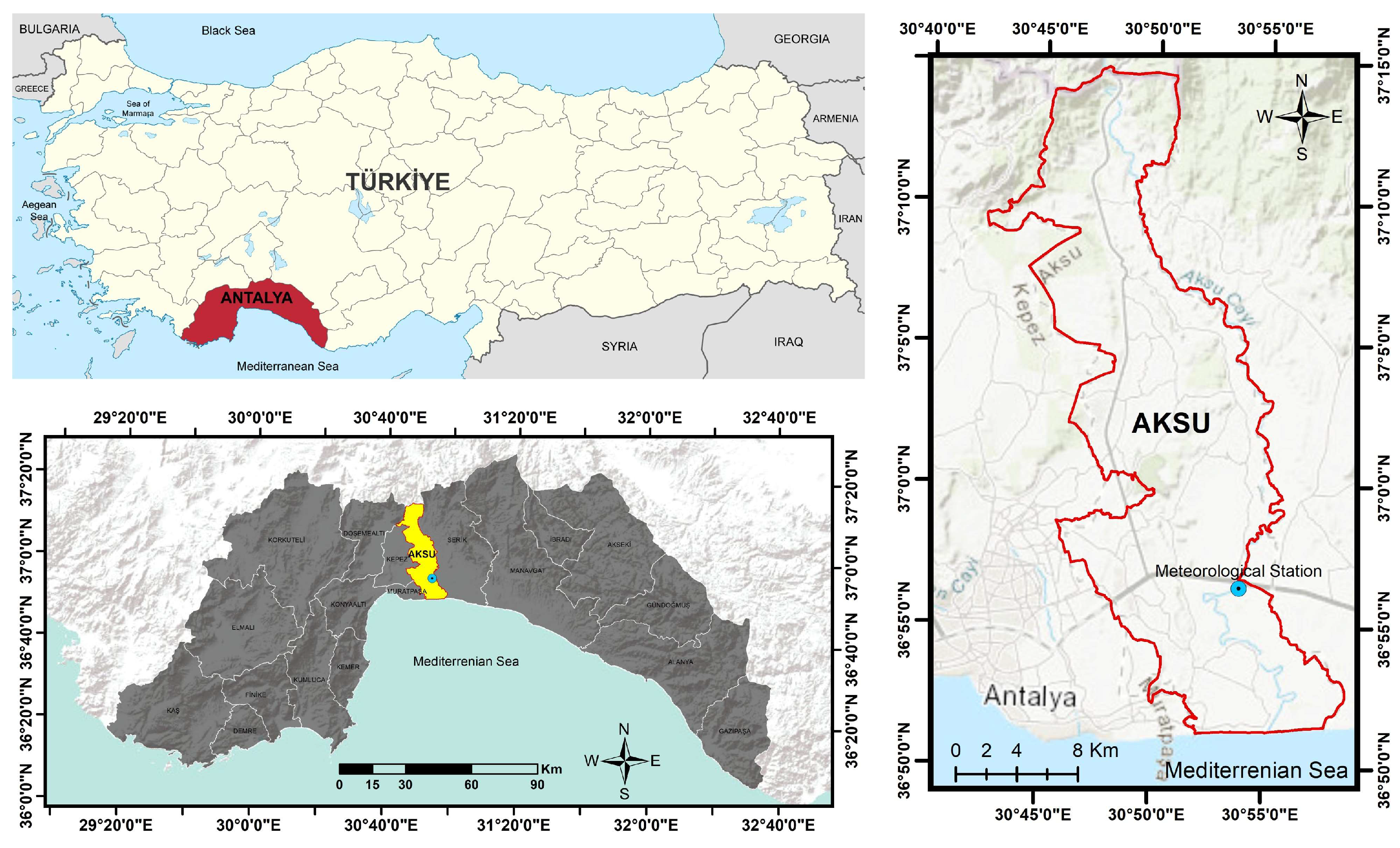
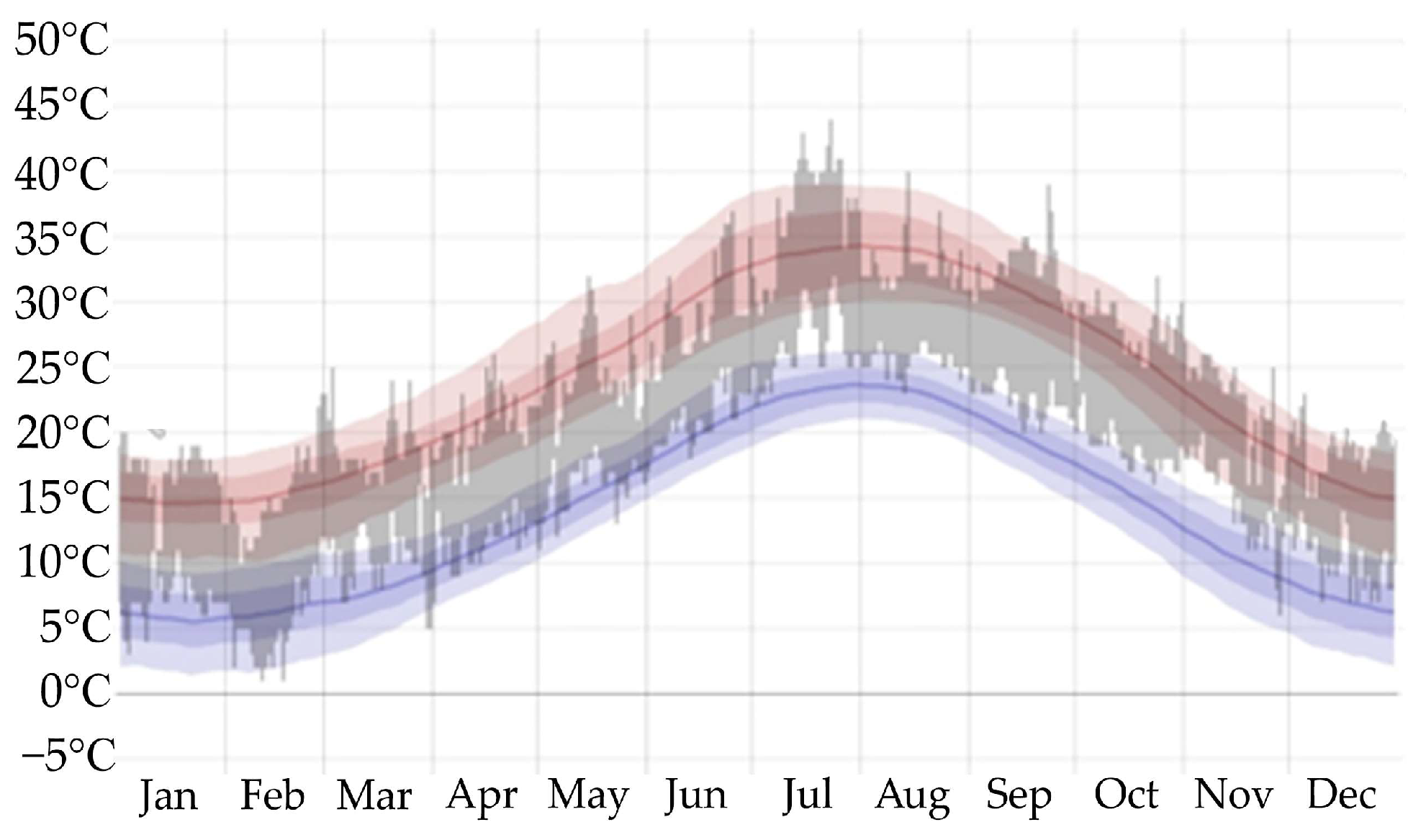



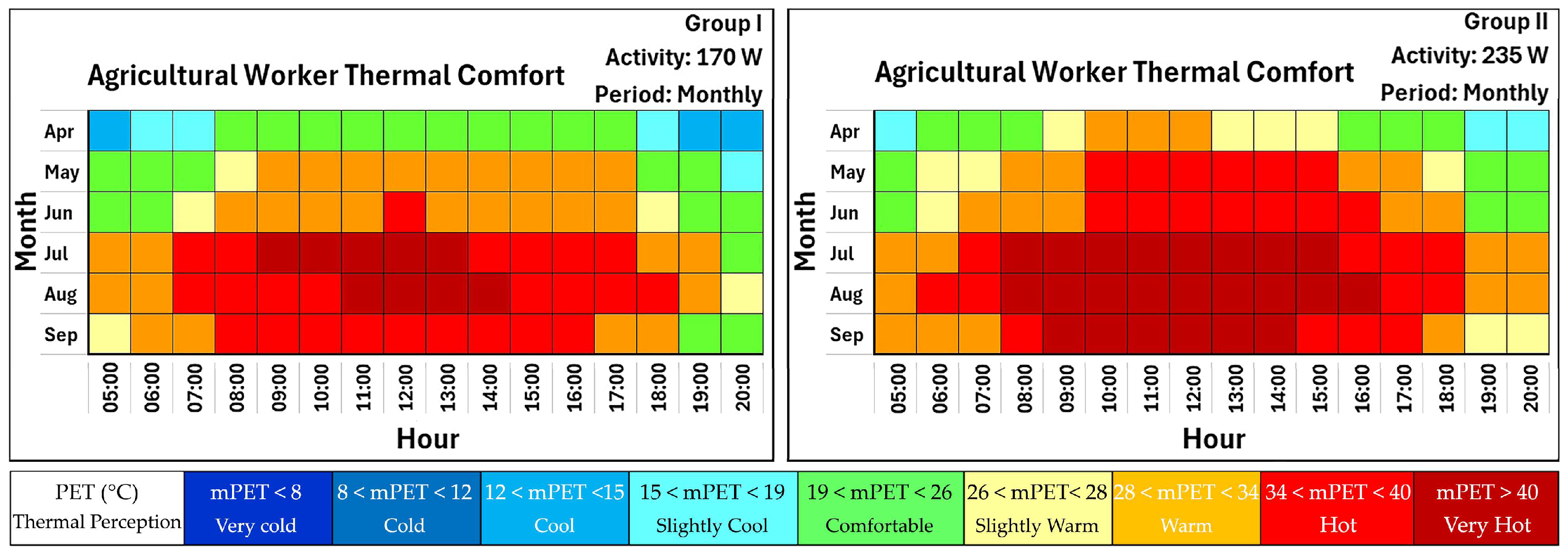
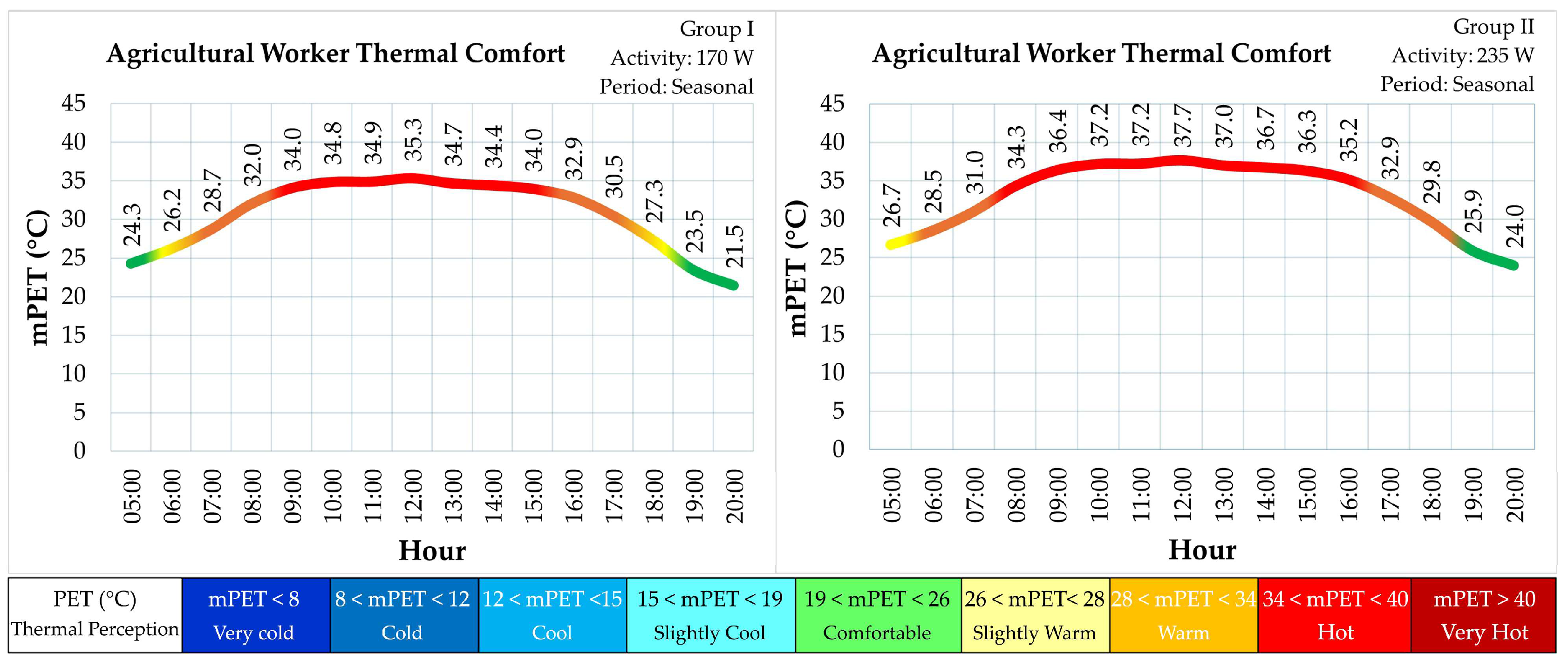
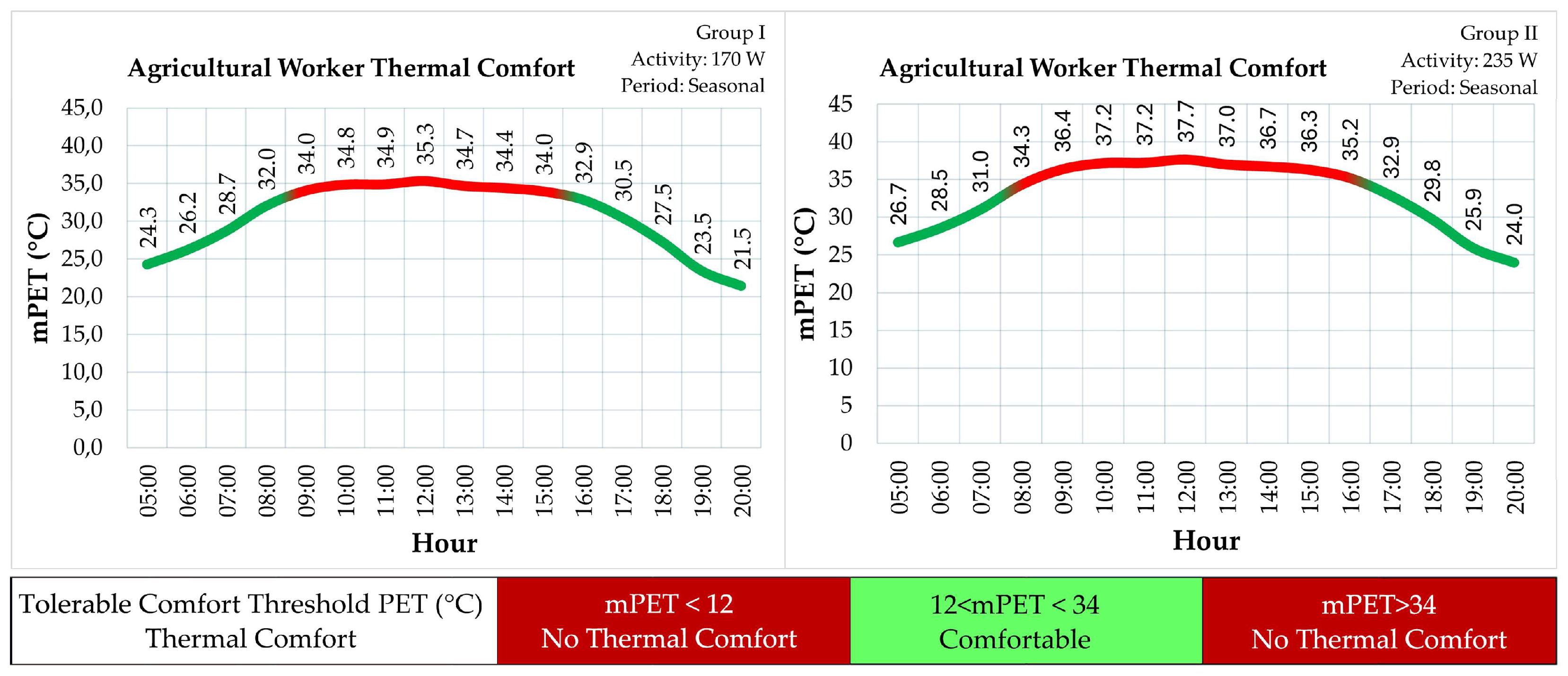
| PET (°C) | Thermal Perception | Grade of Physiological Stress |
|---|---|---|
| <8 | Very cold | Extreme cold stress |
| 8–12 | Cold | Strong cold stress |
| 12–15 | Cool | Moderate cold stress |
| 15–19 | Slightly cool | Slight cold stress |
| 19–26 | Comfortable | No thermal stress |
| 26–28 | Slightly warm | Slight heat stress |
| 28–34 | Warm | Moderate heat stress |
| 34–40 | Hot | Strong heat stress |
| >40 | Very hot | Extreme heat stress |
Disclaimer/Publisher’s Note: The statements, opinions and data contained in all publications are solely those of the individual author(s) and contributor(s) and not of MDPI and/or the editor(s). MDPI and/or the editor(s) disclaim responsibility for any injury to people or property resulting from any ideas, methods, instructions or products referred to in the content. |
© 2024 by the authors. Licensee MDPI, Basel, Switzerland. This article is an open access article distributed under the terms and conditions of the Creative Commons Attribution (CC BY) license (https://creativecommons.org/licenses/by/4.0/).
Share and Cite
Karakuş, N.; Selim, S.; Selim, C.; Olgun, R.; Koç, A.; Ardahanlıoğlu, Z.R.; Şenyiğit Doğan, S.; Ertoy, N. Evaluation of Thermal Comfort Conditions in the Working Environments of Seasonal Agricultural Workers in Csa Koppen Climate Type. Sustainability 2024, 16, 8903. https://doi.org/10.3390/su16208903
Karakuş N, Selim S, Selim C, Olgun R, Koç A, Ardahanlıoğlu ZR, Şenyiğit Doğan S, Ertoy N. Evaluation of Thermal Comfort Conditions in the Working Environments of Seasonal Agricultural Workers in Csa Koppen Climate Type. Sustainability. 2024; 16(20):8903. https://doi.org/10.3390/su16208903
Chicago/Turabian StyleKarakuş, Nihat, Serdar Selim, Ceren Selim, Rifat Olgun, Ahmet Koç, Zeynep R. Ardahanlıoğlu, Sülem Şenyiğit Doğan, and Nisa Ertoy. 2024. "Evaluation of Thermal Comfort Conditions in the Working Environments of Seasonal Agricultural Workers in Csa Koppen Climate Type" Sustainability 16, no. 20: 8903. https://doi.org/10.3390/su16208903
APA StyleKarakuş, N., Selim, S., Selim, C., Olgun, R., Koç, A., Ardahanlıoğlu, Z. R., Şenyiğit Doğan, S., & Ertoy, N. (2024). Evaluation of Thermal Comfort Conditions in the Working Environments of Seasonal Agricultural Workers in Csa Koppen Climate Type. Sustainability, 16(20), 8903. https://doi.org/10.3390/su16208903






